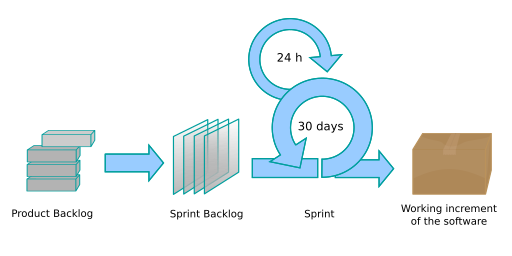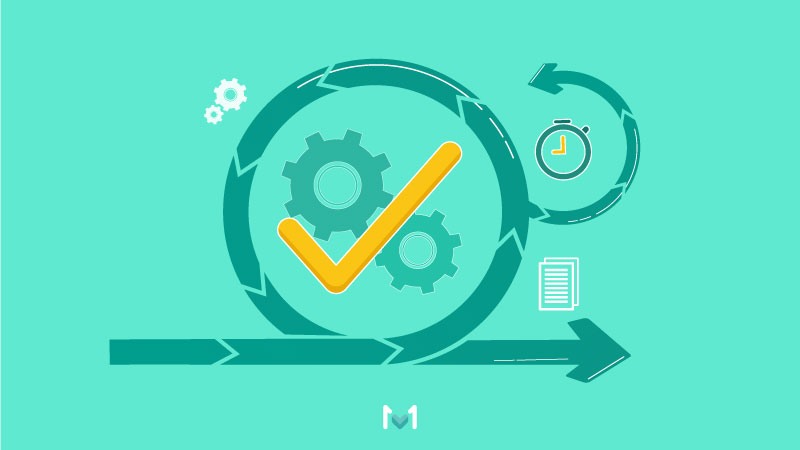What if your team could boost productivity by up to 800%1 while simultaneously improving product quality and job satisfaction?
This is the transformative power of Scrum in project management, the most popular Agile framework, adopted by 81% of Agile teams2 worldwide. By implementing Scrum, your teams can achieve incredible results:
- Teams often see a 300% to 400% increase in productivity, with top-performing teams reaching up to 800%3.
- Scrum’s focus on reducing defect density can lead to a 250% improvement in product quality.4
- 85% of teams5 report that Scrum has significantly improved their work life.
In this blog, we’ll explore why Scrum is a game-changer and how you can harness its principles to elevate your team’s performance and satisfaction.
What is Scrum?

Scrum is a dynamic project management framework designed to handle complex projects by breaking them into focused, time-boxed sprints, typically lasting two to four weeks. Each sprint aims to deliver a potentially shippable product increment, driving continuous improvement through iterative cycles.
In today’s fast-paced business environments, Scrum has become essential for maintaining agility and responsiveness. This allows teams to adapt quickly to changing requirements. According to the 14th annual Agile report6, companies that implement Scrum effectively can see significant improvements up to a 60% faster time-to-market.
This is achieved through Scrum’s structured approach to team roles, regular feedback loops, and its ability to transform team dynamics by fostering accountability and transparency.
The Evolution of Scrum
Scrum originated in the early 1990s7 as a response to the limitations of traditional project management methods like Waterfall. Jeff Sutherland and Ken Schwaber, the co-creators of Scrum, were heavily influenced by a 1986 article in the Harvard Business Review by Hirotaka Takeuchi and Ikujiro Nonaka.


The article, titled “The New New Product Development Game8,” highlighted how successful product development teams operated similarly to a rugby team moving down the field in a scrum formation—working together in a flexible and adaptive manner.
Sutherland and Schwaber applied these ideas to software development, focusing on short, iterative cycles that allowed for rapid feedback and continuous improvement. The first Scrum team was established in 1993 at Easel Corporation, where Sutherland was hired to improve product development. By 1995, they formalized the Scrum process and presented it at the OOPSLA conference, marking its official introduction to the software industry.
The significance of Scrum grew with the signing of the Agile Manifesto in 20019, where both Sutherland and Schwaber were key contributors. Since then, Scrum has become one of the most widely used Agile frameworks in project management, extending beyond software development to industries like healthcare, finance, and education.
Its emphasis on teamwork, adaptability, and continuous improvement has made it a critical tool for modern project management. It enables teams to navigate complex and rapidly changing environments effectively.
What Are Scrum Roles?
Role 1. Scrum Master

A Scrum Master is a pivotal figure within the Scrum framework, responsible for ensuring that the team adheres to Scrum principles and practices. Unlike a traditional project manager, the Scrum Master operates as a servant leader, dedicated to empowering the team rather than directing it.
Their primary role is facilitating the Scrum process, removing obstacles that impede progress, fostering open communication, and guiding the team toward continuous improvement.
What sets a Scrum Master apart is their focus on enabling the team to self-organize and thrive in a collaborative environment. For instance, when a project encounters a major roadblock—like conflicting stakeholder priorities—the Scrum Master steps in to mediate, ensuring that the team can stay on course. They are also responsible for coaching team members in Agile practices, ensuring that Scrum ceremonies like sprints and retrospectives are performed and leveraged to deliver maximum value.
Moreover, the Scrum Master acts as a crucial liaison between the team and external stakeholders, safeguarding the team from distractions while keeping everyone aligned with the project’s goals. This role requires a deep understanding of Agile methodologies, strong facilitation skills, and the ability to navigate complex team dynamics.
In essence, a Scrum Master is the guardian of the team’s productivity and morale, driving the team toward success in an ever-changing project landscape.
Key Techniques for Scrum Masters
Facilitating Team Meetings: Effective meetings are the backbone of a productive Scrum process. A Scrum Master ensures that every meeting—whether it’s a sprint planning session or a daily stand-up—is focused, efficient, and results-oriented.
Coaching Team Members: Beyond teaching principles, a Scrum Master empowers team members to apply these practices in real-world situations. This coaching builds a self-organizing team capable of making critical decisions independently, which is essential for maintaining momentum and delivering consistent value.
Removing Obstacles: A core responsibility of the Scrum Master is to proactively remove impediments that slow down the team. This could involve resolving conflicts, securing resources, or negotiating with stakeholders to minimize disruptions. By swiftly addressing these issues, the Scrum Master ensures that the team remains on track to meet its sprint goals.
Effective Communication: Clear, transparent communication is vital. The Scrum Master facilitates this by ensuring everyone—team members and stakeholders alike—is on the same page. This involves verbal updates and concise, timely documentation that drives alignment and clarity.
Identifying Issues Early: A skilled Scrum Master is always vigilant, spotting potential issues before they escalate. For example, identifying a misalignment between the team and stakeholders early in the sprint can prevent costly rework later. This proactive approach keeps the project moving smoothly and efficiently.
Knowing Your Role: A Scrum Master must clearly understand their role and its boundaries. They guide without micromanaging, ensuring the team retains autonomy while staying aligned with the project’s objectives. This balance is crucial for fostering a collaborative and empowered team environment.
Read More: How To Define Boundaries In a Project ⛔
Role 2. Product Owner

The Product Owner is a key liaison between stakeholders and the development team. They define and communicate the product vision, ensuring the team’s work aligns with the business’s strategic goals. Unlike traditional roles focusing solely on gathering requirements, the Product Owner actively shapes the product, making real-time decisions that steer the project toward success.
Managing the Product Backlog is one of the Product Owner’s most critical responsibilities. This involves prioritizing tasks based on business value, customer feedback, and market trends.
The Product Owner also plays a vital role in sprint reviews, providing the team with clear, actionable feedback that drives continuous improvement. Their ability to balance the competing demands of stakeholders while maintaining a sharp focus on the product vision, ensures that the team delivers maximum value in every sprint.
Decisiveness is another key trait of an effective Product Owner. By saying “no” to less critical requests, they prevent scope creep and keep the team focused on what truly matters. This focus on prioritization and value delivery is essential for maintaining project momentum and ensuring timely, high-quality outcomes.
In essence, the Product Owner is the customer’s voice within the Scrum team, driving the product toward both business objectives and user satisfaction. Their strategic decision-making and ability to prioritize effectively make them indispensable to the success of any Scrum project.
Role 3. Development Team

The Development Team in Scrum is the backbone of product delivery, composed of a self-organizing, cross-functional group of professionals responsible for turning the Product Backlog into a potentially shippable product increment each sprint.
Unlike traditional teams that work in silos, the Scrum Development Team collaborates closely, with every member contributing to various aspects of development—from design to testing—ensuring a holistic approach to product creation.
What sets the Development Team apart is their ability to self-organize and manage their own work without external interference. This autonomy fosters a strong sense of ownership and accountability, crucial for maintaining momentum and delivering high-quality results in fast-paced environments. For instance, in a recent project, a well-coordinated Development Team reduced lead time by 40% by streamlining their workflows and eliminating dependencies on external teams.
The commitment to quality is another hallmark of an effective Scrum Development Team. By integrating continuous testing, peer reviews, and automated processes into their daily work, the team ensures that each product increment meets the highest standards. This proactive approach to quality control prevents defects and accelerates delivery, enabling the team to respond swiftly to changes and feedback.
Furthermore, the development team’s cross-functional nature means that all necessary skills—whether in development, testing, or design—are present within the team, eliminating bottlenecks and enhancing collaboration. In high-performing teams, this cross-functionality allows for a fluid exchange of roles, with team members stepping in where needed to ensure sprint goals are met.
In summary, the Scrum Development Team is a dynamic, self-sufficient unit that drives the project’s success through collaboration, quality focus, and adaptability. Their ability to self-organize and maintain high standards makes them indispensable in achieving the project’s objectives efficiently and effectively.
Read More: What Is Lead Time? Definition, Formula +Reduction Tips
What Are Scrum Artifacts?
1. Product Backlog

The Product Backlog is the strategic backbone of Scrum project management, serving as a dynamic list of tasks, features, and fixes that guide the development team’s work. Managed by the Product Owner, the backlog is not just a repository of tasks but a prioritized plan that evolves with the product. Each item, known as a Product Backlog Item (PBI), is meticulously refined to ensure it delivers maximum value, aligning with both customer needs and business goals.
Effective management of the Product Backlog is critical to project success. In practice, this means regularly refining and reprioritizing items to respond swiftly to changing market conditions and stakeholder feedback. For example, in a recent high-stakes project, the Product Owner’s disciplined backlog management led to a 25% reduction in time-to-market by focusing the team on high-impact features that directly addressed user pain points.
However, managing the Product Backlog comes with challenges. Common pitfalls include scope creep, where the backlog expands uncontrollably, and unclear prioritization, which can lead to wasted effort. To mitigate these risks, a rigorous refinement process—often involving the entire Scrum team—is essential. This process ensures that every item is actionable, aligned with the project’s objectives, and clear enough for the development team to execute effectively.
The transparency of the Product Backlog is another key factor in its effectiveness. By keeping the backlog open and accessible to all stakeholders, the Scrum team ensures alignment and fosters trust, clarifying what the team is working on and why. This transparency drives collaboration and keeps everyone focused on delivering the highest value.
In summary, the Product Backlog is the pulse of Scrum project management. When managed with discipline and strategic insight, it drives the team’s productivity and ensures that the final product meets both business and customer needs. Effective backlog management transforms the development process, enabling teams to adapt quickly, avoid common pitfalls, and consistently deliver high-quality results.
2. Sprint Backlog
The Sprint Backlog is the tactical playbook for the Scrum team, detailing exactly how the team will achieve the Sprint Goal. It’s not just a list of tasks; it’s a living document that evolves daily as the team progresses through the Sprint. Created during Sprint Planning, the Sprint Backlog comprises selected Product Backlog Items, broken down into actionable tasks that the Development Team commits to completing within the Sprint.
Effective management of the Sprint Backlog is crucial for maintaining focus and delivering on Sprint commitments. The team should regularly update the backlog, adjusting tasks as new information arises. For instance, in a recent project, diligent management of the Sprint Backlog allowed a team to identify a major dependency early in the Sprint, reallocating resources to avoid delays and ensuring they met their Sprint Goal on time.
Common pitfalls include failing to update the Sprint Backlog as work progresses or not breaking down tasks sufficiently, leading to unclear responsibilities and missed deadlines. To avoid these issues, the team should treat the Sprint Backlog as a dynamic tool, holding daily stand-ups to review progress and adjust tasks as necessary.
Ultimately, the Sprint Backlog is the roadmap that guides the team through each Sprint. When managed effectively, the team remains aligned, focused, and on track to deliver high-quality work. This disciplined approach to backlog management contributes to Sprint’s success and the overall project’s success, making it an indispensable part of the Scrum framework in project management.
3. Increment

The Increment represents the total of all completed Product Backlog items at the end of each Sprint. More than just a collection of features, each Increment must be fully integrated, tested, and meet the Scrum Team’s rigorous definition of “Done.” This ensures it’s not just usable but potentially shippable, delivering real value to stakeholders.
In fast-paced environments, where speed and quality are paramount, a well-defined Increment can significantly reduce time-to-market. For example, by adhering strictly to their definition of “Done,” a Scrum Team could consistently deliver high-quality, deployable increments every Sprint, resulting in a faster release cycle. This level of discipline prevents the accumulation of technical debt and ensures that each Increment builds seamlessly on the previous one, steadily advancing the product toward its final vision.
However, the Increment can only drive success if common pitfalls are avoided. Inadequate testing or failure to integrate features fully can undermine the Increment’s value, leading to rework and delays. To mitigate these risks, teams must maintain high standards for “Done,” ensuring that each Increment is functional, thoroughly tested, and integrated.
In summary, Increments are not just deliverables but strategic tools that drive the project forward. When managed with discipline and foresight, each Increment builds momentum, keeping the team aligned with the product vision and delivering continuous value to stakeholders.
What Are Scrum Events?
1. Sprint Planning

Sprint Planning sets the direction for the entire Sprint, where the Scrum Team collaboratively decides what can be achieved and how to achieve it. The Product Owner begins by presenting the top-priority items from the Product Backlog, and the Development Team then estimates, discusses, and selects the work they can realistically commit to completing. This isn’t just about choosing tasks—it’s about creating a focused, achievable plan that aligns with the Sprint Goal.
A well-executed Sprint Planning session answers two essential questions: What can we deliver by the end of the Sprint, and how will we get there?
For instance, a clearly defined Sprint Goal in a recent project allowed the team to stay on track despite unexpected challenges, ensuring they delivered all planned features on time. The Sprint Backlog that emerges from this meeting is more than just a list; it’s a strategic plan that guides the team’s work and helps them stay focused.
However, Sprint Planning can easily go off course. Overcommitting or failing to define a clear Sprint Goal can lead to missed deadlines and scattered efforts. To prevent this, the Scrum Master must facilitate the meeting with precision, ensuring that the team is realistic about their capacity and fully aligned on their objectives. A disciplined approach to Sprint Planning sets the stage for a successful Sprint and significantly contributes to the project’s overall success.
In summary, Sprint Planning is the blueprint for a successful Sprint. When done right, it equips the team with the clarity, focus, and direction needed to deliver high-quality results.
2. Daily Standups

Daily Standups, or Daily Scrums, keep the team aligned and focused on the Sprint Goal. Held every day for no more than 15 minutes, this meeting is a quick check-in where each team member shares what they accomplished yesterday, what they plan to do today, and any obstacles in their way. The true power of the Daily Standup lies in its ability to surface issues early, allowing the team to address them before they escalate.
Effective Daily Standups drive accountability and ensure that the team remains agile, constantly adjusting to the realities of the Sprint. For instance, in a recent project, disciplined standups enabled a team to identify a critical blocker within hours, preventing what could have been a significant delay. The Scrum Master’s role is crucial here: they must keep the meeting laser-focused, ensuring it doesn’t devolve into problem-solving or status reporting for management.
Common pitfalls include allowing the meeting to run over time, turning it into a reporting session, or letting team members disengage. To avoid these issues, the Scrum Master must enforce the meeting’s timebox, encourage concise updates, and redirect any off-topic discussions to after the meeting. A well-run Daily Standup keeps the team on track, ensuring that each day’s efforts are aligned with the Sprint Goal.
In summary, Daily Standups are more than just a routine—they are a strategic tool for maintaining team alignment, identifying risks early, and ensuring that Sprint stays on course. When managed effectively, they are instrumental in driving the team’s success and ensuring the timely delivery of high-quality work.
3. Sprint Review
The Sprint Review is held at the end of each Sprint to inspect the completed Increment and adapt the Product Backlog based on feedback from stakeholders. This is not just a demo—it’s a crucial moment for the team and stakeholders to assess progress, validate the work, and make informed decisions about the next steps.
An effective Sprint Review goes beyond showing what was done; it’s a strategic conversation that aligns the team’s output with stakeholder expectations. For instance, in a recent project, a well-facilitated Sprint Review led to the discovery of a critical user experience issue, which was promptly addressed in the following Sprint, resulting in a 20% increase in user satisfaction.
To maximize the value of the Sprint Review, the Scrum Master and Product Owner must ensure active stakeholder engagement and focus the discussion on actionable outcomes. Common pitfalls include turning the meeting into a status report or failing to adapt the Product Backlog based on the feedback received. To avoid this, the Scrum Master should guide the conversation to ensure that it remains productive and that the feedback leads to concrete adjustments in the project plan.
In summary, the Sprint Review is a strategic tool for ensuring that the team’s work stays aligned with stakeholder needs and the overall project vision. When executed effectively, it validates the Sprint’s outcomes and drives continuous improvement and alignment with the project’s goals.
3. Sprint Retrospective

The Sprint Retrospective drives continuous improvement by giving the team a dedicated space to reflect on their process and identify actionable ways to enhance their effectiveness. Held at the end of each Sprint, it’s a time for the team to candidly discuss what worked, what didn’t, and how they can improve in the next Sprint. The goal isn’t to assign blame but to focus on concrete steps to boost performance.
For a Sprint Retrospective to be truly effective, it must be structured yet flexible, with a clear focus on outcomes. The Scrum Master plays a key role here, facilitating the discussion and ensuring that the team identifies the most impactful areas for improvement. For instance, a team can use their retrospective to tackle a recurring bottleneck, reducing cycle time for similar tasks in future Sprints.
However, the value of a Sprint Retrospective might fade away if it becomes routine or if the team fails to act on identified improvements. Common pitfalls include spending too much time on minor issues or not following through on action items. To avoid this, the Scrum Master must keep the discussion focused on high-impact areas, track action items and address them in subsequent Sprints.
In summary, the Sprint Retrospective is not just a reflection on the past but a proactive tool for making each Sprint better than the last. When facilitated effectively, it fosters a culture of continuous improvement and accountability, leading to measurable enhancements in team performance and project outcomes.
Key Performance Indicators (KPIs) in Scrum Project Management
Velocity
Velocity measures the amount of work a team completes during a Sprint, typically in story points. While useful for Sprint planning, its real value lies in identifying trends over time. For example, if Velocity drops consistently, it may signal growing technical debt or team burnout.
To address this, a project manager can initiate backlog refinement sessions or introduce technical spikes to tackle underlying issues, ensuring the team’s sustainable productivity.
Burndown and Burnup Charts
Burndown Charts track the remaining work in a Sprint, offering a clear view of whether the team is on track to meet its goals. A consistent downward trend indicates progress, while deviations can reveal impediments.
On the other hand, Burnup Charts show the amount of work completed versus the total scope, making them ideal for tracking progress in projects with evolving requirements. For instance, if a Burnup Chart shows scope creep, the project manager can intervene to re-prioritize tasks or adjust the scope to keep the project on track.
Lead Time
Lead Time, the duration from when a task enters the backlog to its completion, is a critical measure of workflow efficiency. Long Lead Times often indicate bottlenecks due to excessive work in progress (WIP) or dependencies.
By analyzing Lead Time, a project manager can identify areas where the process needs to be streamlined, such as by limiting WIP or improving cross-functional collaboration. This leads to faster delivery and greater responsiveness to customer needs.
How to Implement Scrum in Your Project Management Process
Step 1: Assembling the Scrum Team
Product Owner
- Must have a deep understanding of customer needs and market dynamics.
- Needs authority to make pivotal decisions that steer the product’s direction.
- Responsible for managing the Product Backlog and prioritizing tasks based on business value.
Scrum Master
- Acts as the process coach and facilitator, ensuring Scrum principles are followed.
- Must excel in conflict resolution and fostering team collaboration.
- Key to navigating challenges during iterative development cycles.
Development Team
- Should be composed of cross-functional professionals with all the necessary skills to deliver a product increment.
- Optimal team size is small enough for agility yet large enough to complete Sprint work effectively.
- Team members should be self-organizing, collaborative, and committed to continuous improvement.
Example: In a recent project, assembling a balanced Scrum Team—mixing experienced developers with a newly certified Scrum Master—boosted delivery pace by 20% after just two Sprints, demonstrating the impact of strategic team composition.
Step 2: Defining the Product Backlog
Product Backlog Overview
- The Product Backlog is the master list of all features, enhancements, bug fixes, and tasks needed to deliver a successful product.
- It’s a dynamic, prioritized set of work items that evolves based on feedback, changing requirements, and market conditions.
Role of the Product Owner
- The Product Owner is responsible for creating and maintaining the Product Backlog.
- Must deeply understand customer needs, business goals, and market landscape.
- Each Product Backlog Item (PBI) should be clearly defined, actionable, and prioritized based on business value and impact.
Effective Backlog Management
- Regular refinement sessions, or backlog grooming, are crucial to ensure the highest-priority items are ready for upcoming Sprints.
- This process keeps the backlog aligned with the project’s evolving goals.
Step 3: Conducting Sprints
Planning and Commitment
- The Sprint begins with clear planning, defining what can realistically be completed.
- The Development Team commits to delivering specific features or fixes.
- The Product Owner ensures alignment with the product vision and maximizes value.
- Balance ambition with feasibility to avoid overcommitting or undercommitting.
Daily Standups (Daily Scrums)
- Daily standups keep the team aligned and focused.
- Assess progress, identify obstacles, and adjust the plan as needed.
- Example: In a high-stakes project, disciplined standups allowed a team to pivot quickly when a critical dependency threatened Sprint.
Transparency and Adaptability
- Continuously inspect and adapt work during the Sprint.
- Re-prioritize tasks, reallocate resources or revisit the Sprint Goal if necessary.
- The Scrum Master facilitates adjustments, keeping the team focused and resilient.
Sprint Review and Retrospective
- At the Sprint’s end, the team demonstrates completed work to stakeholders during the Sprint Review.
- The Sprint Retrospective follows, reflecting on successes and areas for improvement.
- These events ensure continuous improvement and incremental value delivery.
Step 4: Retrospectives for Continuous Improvement
Key Focus Areas:
- What went well
- What didn’t go as planned
- What can be improved
The focus is on creating a culture of openness and learning, not assigning blame.
Role of the Scrum Master
- Facilitates the Retrospective, ensuring honest dialogue and productive discussions.
- Ensures that Retrospective outcomes are actionable, leading to concrete improvements in the next Sprint.
- Examples of actionable outcomes include:
- Adjusting Sprint planning practices
- Enhancing collaboration tools
- Revising the definition of “Done” to maintain quality standards.
Successful Case Studies of Scrum Project Management
John Deere

John Deere10, a global agricultural machinery leader, needed to modernize its technology stack and reduce time-to-market.
- Challenges: The company struggled with siloed teams and slow product development cycles, hindering its competitiveness.
- Scrum Practices: Implemented Scrum and Scrum@Scale across 500+ teams, focusing on improving collaboration and transparency through sprints and Scrum of Scrums.
- Results: Increased enterprise output by 165% and reduced time-to-market by 63%, enabling faster innovation and market responsiveness
- Takeaway: Large-scale Scrum implementation can significantly enhance efficiency and innovation, even in complex, enterprise environments.
Non-Tech Industries: Procter & Gamble (P&G)

P&G11, a global consumer goods giant, sought to streamline operations and improve responsiveness to market shifts.
- Challenges: Inconsistent product launches and supply chain disruptions due to inefficient processes.
- Scrum Practices: Adopted Scrum to improve time-to-market and customer satisfaction, with a focus on iterative progress and cross-functional collaboration.
- Results: Enhanced time-to-market and more reliable product launches, improving customer satisfaction and operational efficiency.
- Takeaway: Scrum’s principles of agility and iterative progress are highly effective in non-tech environments, particularly for enhancing operational consistency and market responsiveness.
Marketing: ShopBetter
ShopBetter, a retail and e-commerce company,12 faced delays in product launches due to poor coordination between teams.
- Challenges: Miscommunication and lack of alignment led to frequent delays and customer dissatisfaction.
- Scrum Practices: Implemented Scrum to improve coordination, using sprints and daily standups to align department efforts.
- Results: Reduced product launch delays by 30%, improving customer satisfaction.
- Takeaway: Scrum can significantly enhance efficiency and delivery speed in marketing initiatives by improving cross-departmental coordination.
Product Development: Lego

Lego13 needed to enhance its innovation process to stay competitive in the fast-paced toy industry.
- Challenges: Slow product development cycles were leading to missed market opportunities.
- Scrum Practices: Adopted Scrum to streamline development cycles, empowering cross-functional teams to make quick decisions and innovate rapidly.
- Results: Faster product launches and a stronger market presence, helping Lego maintain its competitive edge.
- Takeaway: Scrum is highly effective in driving faster, more efficient product development, even in industries not traditionally associated with Agile methodologies.
Scrum vs. Other Project Management Methodologies
| Aspect/Method | Scrum | Waterfall | Kanban | Lean |
| Approach | Agile framework with iterative, time-boxed Sprints and defined roles. | Linear, sequential phases: requirements → design → implementation → testing. | Agile methodology focusing on visualizing work and limiting WIP. | Focuses on eliminating waste, improving efficiency, and maximizing value. |
| Flexibility to Changes | High; can adapt mid-Sprint as requirements evolve. | Low; difficult to change once a phase is completed. | High; continuous delivery and re-prioritization are possible. | Moderate; focuses on efficiency but may struggle with unpredictable changes. |
| Team Collaboration | Strong emphasis on collaboration through roles and ceremonies. | Typically siloed; collaboration is phase-dependent. | Moderate; collaboration occurs, but no prescribed roles or ceremonies. | Moderate; collaboration is encouraged but not structured by the methodology. |
| Iteration and Progress | Iterative; progress through Sprints with regular increments. | Sequential; progress is phase-by-phase with a final deliverable. | Continuous; work is delivered incrementally without time-boxed iterations. | Continuous; focuses on incremental improvements to maximize efficiency. |
| Defined Roles | Yes; Product Owner, Scrum Master, Development Team. | No; roles are typically defined by the organization. | No; roles are not defined, offering flexibility but less structure. | No; roles are flexible and context-dependent. |
| Planning and Predictability | High planning effort with adaptive predictability; Sprints allow regular re-evaluation. | High predictability; detailed upfront planning, but low flexibility. | Moderate; continuous flow allows re-prioritization, but less structured planning. | High in controlled environments; focuses on waste reduction and efficiency. |
| Best Suited For | Projects with evolving requirements; complex, dynamic environments. | Projects with fixed scopes and well-defined requirements. | Ongoing work without fixed deadlines; optimizing flow and efficiency. | Environments requiring continuous process improvement and waste reduction. |
Future of Scrum in Project Management
AI and Machine Learning in Scrum
- Enhanced Planning and Decision-Making: AI analyzes historical data to predict Velocity, identify risks, and optimize task assignments.
- Automated Prioritization: AI tools assist Product Owners by prioritizing backlog items based on business impact and complexity.
- Continuous Improvement: Machine learning provides real-time insights, helping teams refine their processes and improve Sprint retrospectives.
- Proactive Issue Management: AI detects delays and suggests adjustments to resource allocation, allowing for early intervention and maintaining Sprint momentum.
Remote Scrum Practices Post-Pandemic
- Digital Tool Integration: Platforms like Zoom and Slack support virtual standups, Sprint planning, and retrospectives, maintaining team cohesion remotely.
- Asynchronous Communication: Remote teams utilize asynchronous updates to manage time zone differences, ensuring consistent communication.
- Enhanced Collaboration: Digital Kanban boards and collaborative tools provide real-time updates, keeping remote teams aligned and productive.
- Scrum Master Facilitation: Scrum Masters are key in maintaining team morale and an Agile mindset in virtual and hybrid environments.
- Adapting to Hybrid Models: As hybrid work becomes the norm, Scrum must adapt to maintain transparency, accountability, and collaboration across remote and in-office teams.
Conclusion
Scrum is ideal for projects where requirements are likely to change, the scope is not fully defined, and rapid iterations with continuous feedback are needed. It thrives in environments that demand high collaboration, adaptability, and transparency. Scrum’s iterative approach will likely drive success if your project involves complex challenges and the need for an evolving product.
However, traditional methodologies like Waterfall may be more appropriate for projects with a fixed scope and rigid deadlines. Before implementing Scrum in your project management process, assess project’s needs, team experience, and stakeholder engagement.
To effectively integrate Scrum and enhance team collaboration, consider creating a free account on Mirorim. This productivity-first project management software supports Scrum teams with tools for backlog management, Sprint planning, and real-time collaboration, helping your team stay aligned and productive as they work towards your project goals.
FAQ | Scrum Project Management
Agile is a broad project management philosophy that emphasizes iterative development, collaboration, and flexibility. Scrum is a specific Agile framework that provides a structured approach with defined roles, events, and artifacts. While Agile sets the principles, Scrum is a methodology for project management that implements those principles in a repeatable and scalable way.
Sprint Planning: Planning the work for the upcoming Sprint.
Daily Standups (Scrums): Short, daily meetings to synchronize the team’s activities.
Sprint Review: Demonstrating the work completed during the Sprint.
Sprint Retrospective: Reflecting on the Sprint to identify improvements.
The Increment: The sum of all completed Product Backlog items during the Sprint.
No, Scrum is not part of the Project Management Professional (PMP) framework. PMP is based on the PMBOK (Project Management Body of Knowledge), which includes various project management techniques. Scrum is an Agile framework, and while PMP covers some Agile practices, Scrum is a distinct methodology with its own certification, known as Certified ScrumMaster (CSM).
Agile comes first as the overarching philosophy. Scrum is a framework that falls under the Agile umbrella, designed to implement Agile principles in a structured and repeatable manner.
The 80/20 rule, or Pareto Principle, in Scrum, suggests that 80% of the value in a project comes from 20% of the work. Scrum teams often prioritize tasks to ensure that the most valuable work is completed first, thus maximizing the impact of their efforts.
The “3-5-3” framework in Scrum refers to the core structure: 3 roles (Scrum Master, Product Owner, Development Team), 5 events (Sprint, Sprint Planning, Daily Standup, Sprint Review, Sprint Retrospective), and 3 artifacts (Product Backlog, Sprint Backlog, Increment).
The “20-30-50” rule in Scrum is not a widely recognized principle in the Scrum framework and may be a misinterpretation or specific to a particular organization’s practice. For broader applicability, it’s important to stick with well-established Scrum guidelines.
The term “Scrum” is borrowed from the sport of rugby, where a “scrum” is a formation that involves team members packing closely together to move the ball forward. In the context of project management, it reflects the collaborative and close-knit effort of the team working together to achieve goals.
Scrum is best used in projects with complex requirements, where the scope is expected to evolve, and there is a need for frequent feedback and iterative development. It’s ideal for teams that thrive on collaboration and continuous improvement.
Scrum is a time-boxed, iterative approach with defined roles and ceremonies, while Kanban is a continuous flow method focused on visualizing work and limiting work in progress (WIP). Scrum emphasizes fixed-length Sprints and regular ceremonies, whereas Kanban allows for more flexibility without prescribed iterations.
No, Scrum and Six Sigma are different. Scrum is an Agile project management framework focused on iterative progress, while Six Sigma is a data-driven methodology aimed at improving process quality and reducing defects. They serve different purposes but can be complementary in some contexts.
In Scrum, there isn’t a traditional Project Management Office (PMO) role. Instead, responsibilities are distributed among the Scrum Master, Product Owner, and Development Team. The Scrum Master may take on some PMO-like duties but focuses primarily on facilitating the Scrum process.
The choice between PMP and Scrum Master depends on your project management needs. PMP is broader, covering various methodologies, while Scrum Master is specialized in Agile and Scrum. If you work in Agile environments, a Scrum Master certification might be more beneficial, whereas PMP is valuable for a wider range of traditional project management roles.
No, while Scrum originated in software development, it has been successfully applied to various fields, including marketing, product development, and even manufacturing. Scrum’s principles of iterative progress and team collaboration are universal and can be adapted to many industries.
Start with Agile to understand the broader philosophy, then learn Scrum to see how Agile principles are implemented in a structured framework. Understanding both will give you a strong foundation in modern project management.
The Scrum Master typically initiates the Scrum process by facilitating the Sprint Planning session and ensuring the team adheres to Scrum principles throughout the Sprint.
Yes, Microsoft has adopted Scrum in various teams and projects to enhance collaboration, improve product development cycles, and increase flexibility in meeting customer needs.
Scrum Master: Facilitates the process, removes impediments, and ensures the team follows Scrum practices.
Product Owner: Manages the Product Backlog, prioritizes work, and ensures that the team delivers value.
Development Team: Cross-functional members who work collaboratively to deliver the product increment.
The Daily Standup (or Daily Scrum) is limited to 15 minutes to ensure the meeting stays focused and efficient. It’s designed to quickly synchronize the team’s activities and address any immediate impediments.
The “two pizza rule” suggests that a Scrum team should be small enough to be fed two pizzas. This rule maintains a manageable team size that can operate efficiently without communication overhead.
The “15-10-5” rule isn’t a standard Scrum principle. It may refer to specific time management practices within a particular organization or context. It’s important to rely on established Scrum guidelines.
Scrum teams are typically small, with 3 to 9 members, to maintain agility and effective communication. This size ensures the team is large enough to complete significant work, yet small enough to collaborate efficiently.
Transparency: Ensuring all aspects of the process are visible to those responsible for the outcome.
Inspection: Regularly examining Scrum artifacts and progress toward the Sprint Goal.
Adaptation: Adjusting processes and plans as needed based on what has been learned.
The “3 P’s” in Scrum are not a formalized concept in the Scrum framework. However, some might refer to them as People, Product, and Process, emphasizing the importance of the team, the product being developed, and the process that guides the work.
There’s no set number of Sprints in Scrum. The number of Sprints depends on the project’s scope and timeline. Each Sprint should deliver a potentially shippable product increment, with the process continuing until the product is complete.
The Scrum Master’s rule is to facilitate the Scrum process, ensure the team adheres to Scrum principles, remove impediments, and protect the team from external interruptions, enabling them to focus on delivering high-quality work.
The “first of 5” is not a standard Scrum concept. It may refer to specific practices or steps used within an organization. It’s best to adhere to the established Scrum framework, which includes well-defined roles, events, and artifacts.
There isn’t a one-size-fits-all answer. Scrum is highly effective for many projects, but other methodologies like Kanban, Lean, or traditional Waterfall might be better suited depending on the project’s nature, team dynamics, and business goals.
Scrum might not be the best fit for projects with a fixed scope, rigid timelines, or well-defined requirements that are unlikely to change. It’s also less suitable for very large teams or projects where the work is highly predictable and doesn’t benefit from iterative feedback. In such cases, traditional project management methodologies like Waterfall may be more effective.
Additional Resources
Books
- “Scrum: The Art of Doing Twice the Work in Half the Time” by Jeff Sutherland
This book, co-written by one of the co-creators of Scrum, Jeff Sutherland, provides an in-depth look at the principles of Scrum and how they can be applied to increase efficiency and productivity across various industries. It’s a must-read for anyone serious about mastering Scrum. [Get it on Amazon] - “Scrum: A Pocket Guide” by Gunther Verheyen
Often referred to as “the definitive guide to Scrum,” this book offers a concise and practical overview of Scrum. It’s perfect for both beginners and seasoned professionals who need a quick reference. [Get it on Amazon]
Courses
- Scrum Master Certification from Scrum.org
Scrum.org offers a range of courses designed for different levels of Scrum expertise. The Professional Scrum Master (PSM) course is ideal for those looking to gain a deep understanding of the Scrum framework and prepare for the PSM certification exam. [Explore the course] - Certified ScrumMaster (CSM) from Scrum Alliance
The CSM course from Scrum Alliance is one of the most recognized certifications in the Agile community. This course covers the fundamentals of Scrum, preparing participants for the Certified ScrumMaster (CSM) exam. [Learn more]
Certifications
- Professional Scrum Master (PSM) from Scrum.org
The PSM certification is globally recognized and offers three levels of certification. PSM I is ideal for beginners, while PSM II and PSM III are for those with more experience. The certification is well-respected and demonstrates a strong understanding of Scrum principles. [Learn More] - Certified Scrum Product Owner (CSPO) from Scrum Alliance
For those interested in the Product Owner role, the CSPO certification from Scrum Alliance is a valuable credential. It focuses on the responsibilities of a Product Owner in maximizing the value of the product and the work of the Development Team. [Learn More]
References
- Scrum The Art of Doing Twice the Work in Half the Time. (2017, May 31). Scrum Inc. https://www.scruminc.com/new-scrum-the-book/ ↩︎
- 17th State of Agile Report | Analyst Reports | Digital.ai. (n.d.). Digital.ai. https://digital.ai/resource-center/analyst-reports/state-of-agile-report/ ↩︎
- Scrum The Art of Doing Twice the Work in Half the Time. (2017, May 31). Scrum Inc. https://www.scruminc.com/new-scrum-the-book/ ↩︎
- THE IMPACT OF AGILE. QUANTIFIED. (2021). https://docs.broadcom.com/doc/the-impact-of-agile-quantified ↩︎
- Scrum Alliance. (2017). State of Scrum 2017-2018. In State of Scrum. https://www.scrumalliance.org/ScrumRedesignDEVSite/media/ScrumAllianceMedia/Files%20and%20PDFs/State%20of%20Scrum/2017-SoSR-Final-Version-(Pages).pdf ↩︎
- State of Agile Survey 14th Annual Report. (2019). In State of Agile Survey. https://www.qagile.pl/wp-content/uploads/2020/06/14th-annual-state-of-agile-report.pdf ↩︎
- Scrum: A Brief History of a Long-Lived Hype. (n.d.). Scrum.org. https://www.scrum.org/resources/blog/scrum-brief-history-long-lived-hype ↩︎
- Takeuchi, H. (2014, August 1). The New New Product Development Game. Harvard Business Review. https://hbr.org/1986/01/the-new-new-product-development-game ↩︎
- Dybå, T., & Dingsøyr, T. (2008). Empirical studies of agile software development: A systematic review. Information and Software Technology, 50(9–10), 833–859. https://doi.org/10.1016/j.infsof.2008.01.006 ↩︎
- Agile Unleashed at Scale: John Deere Case Study – Scrum Inc.TM. (2022, June 26). Scrum Inc. https://www.scruminc.com/agile-unleashed-scale-john-deere-case-study/ ↩︎
- Agile Methodology: Lessons to Learn from Non-Tech Businesses. (n.d.). https://www.cascade.app/blog/agile-methodology-in-non-tech ↩︎
- Rememo, & Rememo. (n.d.). Agile Beyond Technology: Case Studies in Non-Program Industries. Free Kanban & Chat. https://rememo.io/blog/agile-beyond-technology-examples-in-non-programming-environments ↩︎
- Rememo, & Rememo. (n.d.). Agile Beyond Technology: Case Studies in Non-Program Industries. Free Kanban & Chat. https://rememo.io/blog/agile-beyond-technology-examples-in-non-programming-environments ↩︎

